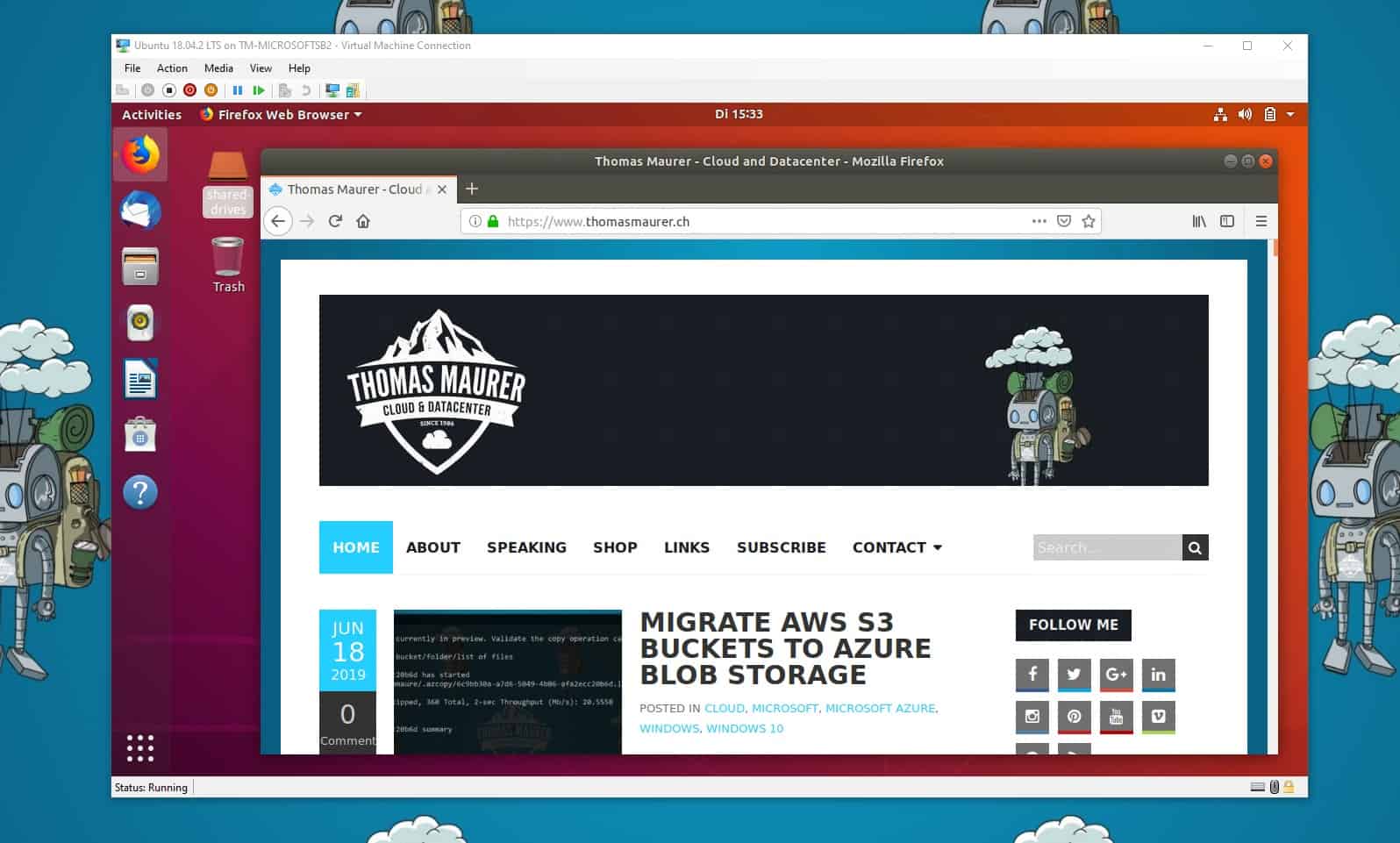

- #VIRTUALMACHINE UBUNTU ON WINDOWS 10 INSTALL#
- #VIRTUALMACHINE UBUNTU ON WINDOWS 10 DRIVERS#
- #VIRTUALMACHINE UBUNTU ON WINDOWS 10 WINDOWS 10#
- #VIRTUALMACHINE UBUNTU ON WINDOWS 10 PRO#
- #VIRTUALMACHINE UBUNTU ON WINDOWS 10 ISO#
The cookie is used to store the user consent for the cookies in the category "Other. This cookie is set by GDPR Cookie Consent plugin. The cookies is used to store the user consent for the cookies in the category "Necessary". The cookie is set by GDPR cookie consent to record the user consent for the cookies in the category "Functional". The cookie is used to store the user consent for the cookies in the category "Analytics". These cookies ensure basic functionalities and security features of the website, anonymously. Necessary cookies are absolutely essential for the website to function properly. If you have any questions, please let me know in the comments.
#VIRTUALMACHINE UBUNTU ON WINDOWS 10 WINDOWS 10#
I hope this gives you a step-by-step guide, how you can create an Ubuntu VM on Windows 10 using Hyper-V. This allows you to use features like Hyper-V Enhanced Session Mode, which enables you also to use copy-paste, and others.
#VIRTUALMACHINE UBUNTU ON WINDOWS 10 DRIVERS#
This will boot you in the Ubuntu installation, where you can set up your Ubuntu operating system.Īll the specific Hyper-V drivers for Ubuntu, are already included in the image. If you enable Secure Boot for a Linux virtual machine, make sure you change the Secure Boot template to Microsoft UEFI Certificate Authority. Optional: If you click on Edit settings, you will be able to configure the virtual machine hardware settings like vCPU or vRAM. This will start downloading the virtual machine image.Īfter the image is downloaded, you can either connect to the virtual machine and start it, or you can first modify the virtual machine settings.
#VIRTUALMACHINE UBUNTU ON WINDOWS 10 INSTALL#
Select the Ubuntu version you want to install and click on Create Virtual Machine. These are prepared Hyper-V virtual machines images, ready for you to download and install. In the Hyper-V VM Gallery, you will find not just two Windows 10 virtual machines you will also currently find Ubuntu 18.04 LTS and Ubuntu 19.04. However, there is a much easier way, using the Hyper-V Quick Create feature.
#VIRTUALMACHINE UBUNTU ON WINDOWS 10 ISO#
To create an Ubuntu virtual machine on Windows 10 Hyper-V, you could download the Ubuntu ISO file and install it like any operating system. Create an Ubuntu virtual machine on Windows 10 The easiest way to enable Hyper-V on Windows 10 is to run the following PowerShell command as an administrator:Įnable -WindowsOptionalFeature -Online -FeatureName:Microsoft -Hyper -V -AllĪfter you have installed Hyper-V, you need to restart your computer. CPU support for VM Monitor Mode Extension (VT-c on Intel CPU’s).64-bit Processor with Second Level Address Translation (SLAT).Windows 10 Enterprise, Professional, or Education (Home does not have the Hyper-V feature included).Hyper-V on Windows 10 has the following requirements:


Install Hyper-Vįirst, you will need to install Hyper-V on your Windows 10 computer. If you want to know more about Hyper-V on Windows 10, check out the Microsoft Docs. In this blog post, I am going to show you how you can create an Ubuntu VM on Windows 10 using Hyper-V. You can not just run Windows virtual machines, and you can also run Linux virtual machines. With Hyper-V, you can create virtual machines running on Windows 10, without the need for third-party software. This is the same hypervisor which powers virtualization in Windows Server and the Microsoft Azure datacenters.
#VIRTUALMACHINE UBUNTU ON WINDOWS 10 PRO#
Under Hyper-V Requirements, if the result reads Yes, then you can run Hyper-V.Windows 10 is not just a modern desktop operating system, and it also has some great IT Pro and Developer related features build in.Type the following command and press Enter: systeminfo.exe.Search for Command Prompt and click the top result.You can quickly verify your computer has the required support for Hyper-V using Systeminfo: In addition, you have to make sure the Virtualization Technology and Hardware Enforced Data Execution Prevention options are enabled on your system BIOS. Processor must support VM Monitor Mode Extension (VT-c on Intel chips).64-bit CPU with Second Level Address Translation (SLAT).Verifying Hyper-V supportĪlthough Hyper-V is part of Windows 10, there is a minimum hardware requirement a computer must meet to enable the feature. Hyper-V is a virtualization technology from Microsoft available on Windows 10 Pro, Enterprise, and Education, and it allows you to create one or multiple virtual machines to install and run different OSes on the same physical hardware. However, it's possible to install version 16.04, which might be a more stable version of the open source project, and you can also install other distros, including: In this guide, we'll be using Ubuntu version 17.10, which you can download from the official Ubuntu website.



 0 kommentar(er)
0 kommentar(er)
